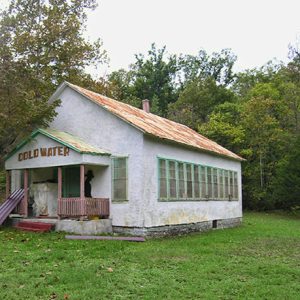calsfoundation@cals.org
Cold Water School
The Cold Water School, which is listed on the National Register of Historic Places, is located in the former village of McPhearson (Baxter County) and was one of the earliest schools in Baxter County. The first building was constructed in the late 1880s, as population growth had necessitated a school. The second building, which still stands in the twenty-first century, was built between 1920 and 1926. This one-room schoolhouse was used as a school, church, and community center. The Cold Water School is the oldest and only surviving structure in McPhearson and is located twenty-five miles south of Mountain Home (Baxter County).
As early as 1829, the Arkansas Territorial Legislature passed laws concerning public schools. The first laws allowed the state’s towns to appoint trustees who were responsible for raising money and establishing schools. Ultimately, this meant that the school system was a subscription-based system. In 1843, the state legislature passed laws establishing public school systems based on revenue from public taxes. However, sparse settlement of the rural Baxter County meant a funding deficiency and required additional payments from those who wished to attend school—in effect a continuation of the subscription system common at the time. This greatly limited educational opportunities in Baxter County.
The locations of the first public schools in Baxter County depended primarily on citizen action. When a community had a population of children large enough to warrant the establishment of a school, the citizens came together to select a central location and to raise the money or provide the labor to erect a building. Oral tradition holds that the first school in the community of McPhearson was on the same grounds as the current Cold Water School. It was a frame structure with the timber provided by the local sawmill.
According to oral history, this school burned completely in the 1910s. The second Cold Water School was built between 1920 and 1926 as District No. 21, though it is unknown why it was named the Cold Water School. It is a stucco building with double-hung, four-over-four windows, unpainted with a brass bell.
Mae Strubhar provided her personal accounts of teaching at the school in her memoir, Ozark Memories. Strubhar, who taught in the 1942–43 and 1943–44 school years, relates that it was difficult adjusting to life in the middle of the woods. The school year began in July, and Strubhar related, “When school started…the hot weather sapped our energy. It was a nice time of the year to make overnight visits to the homes of my pupils.” Strubhar also noted, “The school house was equipped with nice desks and was a stuccoed building, painted on the inside.” The school had “outdoor restroom facilities and a level grass-covered play ground with plenty of space for a good softball diamond and other games at the same time.” An oral history from Normalea Acklin, a student at the school in the late 1930s, related that students “all went to school barefoot. When it was getting to be cold I remember at recess I’d go out and play then run to warm my feet at a big old wood burning stove in the middle of the room.”
By the 1940s, McPhearson had reached its peak population. Logging in the area was slowing; the cotton economy was difficult, at best, for farmers in the Ozarks; and the Great Depression had driven many people from the community in search of more prosperous lives elsewhere. The community continued to dwindle until the school system consolidated with the Big Flat School in the early 1960s.
The Cold Water School was listed on the National Register of Historic Places on May 29, 2008.
For additional information:
“Cold Water School.” National Register of Historic Places nomination form. On file at Arkansas Historic Preservation Program, Little Rock, Arkansas. Online at http://www.arkansaspreservation.com/National-Register-Listings/PDF/BA0148.nr.pdf (accessed November 9, 2021).
Strubhar, Mae. Ozark Memories. N.p.: Edgewood Press, 1945.
Travis A. Ratermann
Arkansas Historic Preservation Program
 Early Twentieth Century, 1901 through 1940
Early Twentieth Century, 1901 through 1940 Historic Preservation
Historic Preservation Cold Water School
Cold Water School 




Comments
No comments on this entry yet.